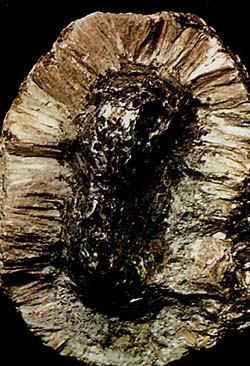Stone, minerals and semiprecious of the world stone -->rus
Diagnostic cart.
(Mg, Fe)7 (OH)2 (Si4 O11 )2
Hardly ever does not meet as distinct crystals; more frequent presented radiant and fibred aggregates, and also lamellar tabular dense the masses. Colors dirty-white, grey, brown-yellow, gold or brown.
Diagnostic indication.
Does not dissolve in acids, hardly melt fuse in flame of candle.
Origin provenance genesis.
In nature little widespread, be found in crystalline slates (gneiss, amphibolites, chloritic slates, peridotite serpentinite and other) and in some contact deposit-metamorphic rocks.
Deposit minefield mine field occurrence subsoil.
This mineral is known in Kongsberge (Norway) and some places in Finland, Greenland and USA. In Italy anthophyllite a-plenty be found among the metamorphized including of granites of San-fedelino (Novate-meccola, province of Sondrio). Marked also in mica slates in Val'-passiriya and, in interleave, interstratify with a serpentine, in Monte-karane (an island Elba).
If you called of the Internet search on these webpages on direct reference from the searching systems, and this material appeared for you too difficult, recommend the visit of a section "Catalogue of popular stone"
Poisonous and radioactive risky hazardous cargo stone and minerals
** **
Adamite * Annabergite * * Antimonite * Arsenolite ** Arsenopyrite ** Orpiment, ** Baildonite * Beryl ** Blomstrandite, Betafite ** Billietit ** Bismutite * Breithauptite * Witherite * Gadolinite ** Halite, Mine * * Geocronite * Glaukodote * Descloisite * * Jordanite * Carnotite ** Cinnabar, ** Cobaltite * Cottunite * Liroconite * Marcasite * Monacite * Ammoniac * Nikeline * Otenite ** Pyromorfite * Chalcolamprite, Pyrochlorine * Prustite * Rammelsbergite * Realgar ** Mercury, Quicksilver * Senarmontite * Sulphur, Sulfur, * Skutterudite * Strontianite * * Antimony, * Tetrahedrite * Thorianite ** Thorite ** Uraninite ** Pharmacolite * Halkozine, * Hatchinsonite * Celestine * * Zircon ** Evksenite ** Enargite * Eshinite ** Conichalcite *
Stone, minerals and semiprecious of the world stone group screening
** **
Native elements: Diamond Graphite, Iron Gold Copper Platinum Mercury, * Sulphur, Sulfur, * Silver Antimony, * Sulphide: Antimonite * Arsenopyrite ** Orpiment, ** Bismutite * Breithauptite * Galena, Glaukodote * Jordanite * Cinnabar, ** Cobaltite * Marcasite * Molybdenite Nikeline * Pyrite Pyrrotine Prustite * Rammelsbergite * Realgar ** Skutterudite * Sphalerite Tetrahedrite * Halkozine, * Chalcopyrite Hatchinsonite * Enargite * Pyroxene (silicates): Diopside Jadeite Spodumene Halogenoide, halogenide, Halite, Mine * * Cottunite * Ammoniac * Fluorite Spinel Magnetite Minium, Spinel Oxide and Arsenolite ** Blomstrandite, ** Billietit ** Hematite Goethite Quartz Corundum Limonite Opal Polianite, Pyrohroite Rutile Senarmontite * Thorianite ** Uraninite ** Chalcedony Zincite Evksenite ** Eshinite ** Other: Astrophyllite Petrified Amber Carbonate: Azurite Aragonite Dolomite Calcite Malachite Siderite Strontianite * * Trona, throne Ulexite Sulphate: Barite Woulffenite Gypsum Crocoite Celestine * * Phosphate: Adamite * Annabergite * * Apatite Baildonite * Turquoise Vanadinite Vivianite Descloisite * * Carnotite ** Liroconite * Monacite * Otenite ** Pyromorfite * Pharmacolite * Silicate: Andalusite Gadolinite ** Datolite Disthene, Olivine Topaz Thorite ** Zircon ** Euclase Epidotes Beryl ** Cordierite, Tourmaline Eudialyte Epidote Garnets Grossuliare Arizona ruby, Uvarovite Mica, isinglass stone Biotite, Lepidolite Chlorites Clinochlore Serpentine Chrysocolla Feldspar (silicates): Microcline Orthoclase Spar (silicates): Lazurite, Sodalite Amphiboles Anthophyllite prehnite Rhodonite Talcum, talc Types of minerals
A Home page aboute stone Zodiacs, horoscopes stones Medical stone therapeutics Magic properties of the stone Free download the books * Higher mathematics (rus) * About a house & nature (rus) * Role-playing game RPG (rus) All about jewels color stone About of the world minerals About of the popular stone* jewels color gem stones* gemstones color stones* semi-precious stones* original color stonesDeposit semiprecious stones It interestingly, about stone Sales of the stone Pendants, souvenirs, stones Beads, bangles from stones Stone, crystals, collections Balls, eggs, pyramids stone Beads for the man, stones Nephrite, massager, video Bronze miniatures on a stone Works "Opere Plumarii"
Internet shop , market, sale of souvenirs and accessories (rus.) * Sale of souvenirs , bags from a skin, beads, rosary, wares from a wood, bronze * Belts, bags, skin , original and rare accessories of modern garment-and-fancy clothes * Bangles, ear-rings , rings, "Hunter of sleeps", pendants, souvenirs of hand-worked * Dolls of reeling of hand-made, original souvenirs as the charm, talisman, amulets * Sale the skulls of cow , lease, produce of a bead, necklace, card of hand-made
A Home |
It interestingly |
Catalogue of minerals |
Catalogue of stone |
Horoscopes |
Medical stone |
Magic of stone
Sales: |
Pendants, souvenirs |
Beads, bangles |
Stone, crystals, collections |
Beads, internet shop of the Kharkov Ukraine CIS | Miniatures of a bronze
 Diagnostic cart.
Diagnostic cart.

